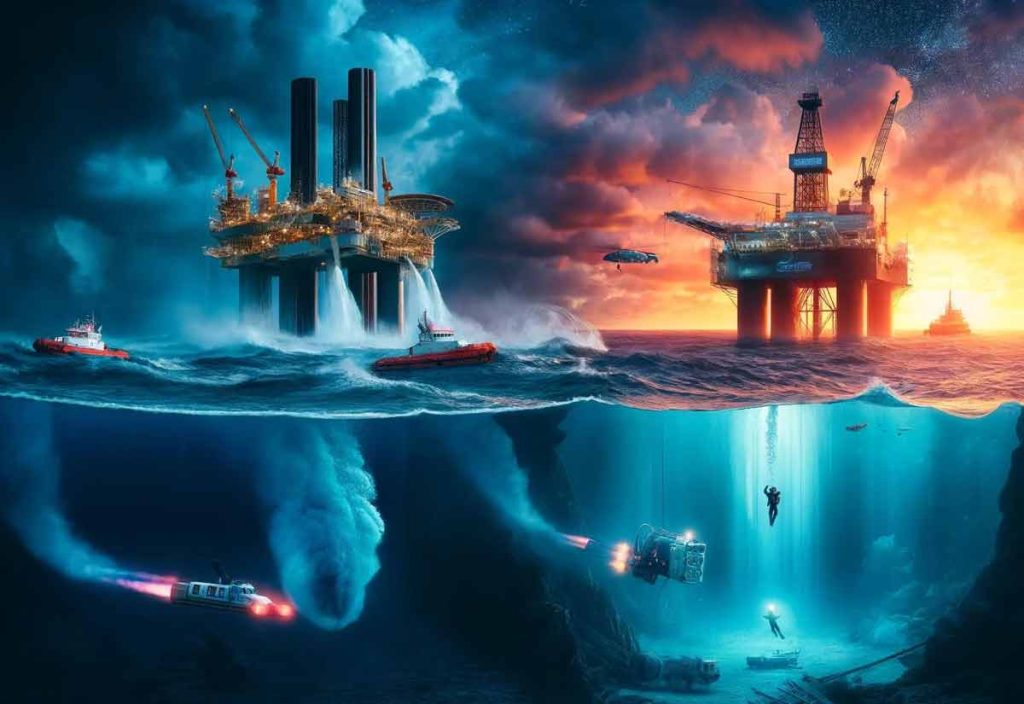Imaging AI DALL-E’s rendition of modern offshore efforts to tap the high-stakes Paleogene deposit.
From the precarious beginnings of Thunder Horse oil platform to the catastrophic Deepwater Horizon spill, to current aspirations for untapped resources in the Paleogene formation, BP’s journey reflects the high-stakes nature of deep-water oil and gas production.
“Using a geology-based assessment methodology, the U.S. Geological Survey estimated mean undiscovered, technically recoverable conventional resources of 100 million barrels of oil and 16.5 trillion cubic feet of gas in the downdip Paleogene formations in onshore lands and State waters of the U.S. Gulf Coast region.”
BP’s Pivot Back to Fossil Fuels: Grand Aspirations For a Fossil Future in 2024
The provided excerpt from the WSJ article BP Goes Deeper Into Gulf of Mexico After Triumphs and Tragedy shines the spotlight on BP’s shift back toward its oil and gas roots and the role of the Gulf of Mexico as a central component in this strategy. The article highlights the challenges and opportunities associated with this move, emphasizing the tightrope BP is walking between short-term financial gains and long-term environmental considerations.
- Shift Back to Fossil Fuels: Under new CEO Murray Auchincloss, BP is moving away from its previous focus on renewable energy and doubling down on fossil fuels, driven by higher returns and pressure from shareholders. This shift aligns with the global energy landscape, where fossil fuels still dominate the energy mix, despite growing investments in renewables.
- Gulf of Mexico as a Growth Engine: BP views the Gulf as its core for deep-water ambitions, with existing infrastructure, operational expertise, and potential for new discoveries, particularly in the Paleogene formation. However, the profitability of these projects remains uncertain due to higher production costs and market fluctuations.
- Balancing Returns with Environmental Pressure: BP faces the challenge of balancing its need for profitability and shareholder returns with its commitment to reduce carbon emissions. The article mentions BP’s focus on more efficient platforms and the use of AI for predictive maintenance as ways to minimize costs and improve safety while mitigating environmental impact.
- Pressure to Reduce Spending on Green Energy: Some investors are pressuring BP to divert funds from renewable energy to fossil fuel development. This highlights the ongoing debate within the energy sector about the pace and scale of the transition to a low-carbon future.
- Opportunity for Innovation: BP’s focus on AI and advanced technologies to optimize production presents opportunities for further innovation in the deep-water sector, potentially paving the way for more sustainable and cost-effective operations in the future.
- Uncertainty and Time Pressure: The future of the oil and gas industry remains uncertain, and BP faces the pressure of developing newly discovered reserves quickly to maximize returns before potential restrictions on fossil fuels come into play.
- Focus on Efficiency and Cost Reduction: BP’s strategy emphasizes using existing infrastructure, replicating successful models, and utilizing advanced technologies to reduce project development time and operating costs, increasing the potential profitability of new projects.
BP’s shift back to fossil fuels reflects the complex realities of the global energy transition, where both fossil fuels and renewables play significant roles. The company’s focus on efficiency, innovation, and cost reduction in the Gulf of Mexico could serve as a model for other players in the deep-water sector.
The balance between short-term financial gains and long-term environmental considerations remains a critical challenge for all energy companies. BP’s success in weathering this challenge will depend on its ability to develop and deploy innovative technologies that optimize production while minimizing carbon emissions.
The timeframe for the energy transition remains uncertain, but the clock is ticking for companies like BP to make strategic investments that will secure their long-term viability in a rapidly changing 21st-century energy landscape.
BP Overcoming a Legacy of Ambition and HR Setbacks:
Thunder Horse stands as a symbol of BP’s grand aspirations in the Gulf, initially boasting impressive engineering feats but plagued by safety issues and delays. The Deepwater Horizon disaster in 2010 cast a dark shadow on BP’s legacy, demonstrating the devastating environmental and financial consequences of negligence in such high-risk operations.
But the company also had to deal with a significant HR problem at the highest level when a certain CEO Bernard Looney lived up to his name in a mysterious “personal relationships’ scandal. BP confirmed Mr Auchincloss as CEO in January after a months-long search to replace Mr Looney after his resignation over personal relationships with colleagues.
“The company later concluded Mr Looney “knowingly misled” the board over the scandal, dismissing him without notice as of 13 December. As a result, Mr Looney initially stood to forfeit up to £32.5m in earnings, however BP has now confirmed the total remuneration forfeited to be closer to £28Mr Looney took a £1.8 million overall hit to his remuneration in 2023 after BP applied a total of £2.98m in “malus and clawback” for the year. He also paid back 50% of his cash bonus for 2022, equalling £420,000.”
Current Ambitions and Strategies:
Despite past challenges, BP remains committed to the Gulf, viewing it as its key source of production and future growth. With Thunder Horse operating steadily and the new Argos platform online, BP aims to leverage existing infrastructure for new projects. Targeting the vast Paleogene deposits offers significant potential but requires advanced technologies to handle extreme pressure and temperatures.
Challenges and Potential for Consolidation:
BP faces stiff competition as smaller rivals like Shell and Chevron achieve success with new discoveries and large-scale production projects. As a smaller supermajor compared to Exxon and Chevron, BP’s limited scale could be a disadvantage, leading to speculation about potential acquisitions or partnerships. The recent merger between Exxon and Chevron will further intensify competition for resources and expertise in the deep-water arena.
Resource Erectors’ Perspective on BP and the Fossil Future
BP’s experience is a case study of the inherent risks and potential rewards of deep-water exploration and production. Successful execution in the Gulf will require a balance between technological innovation, operational excellence, and a strong environmental and safety record. Strategic partnerships, joint ventures, and potential consolidation within the industry could reshape the competitive landscape and offer various opportunities for collaboration and growth.
BP’s story in the Gulf of Mexico has yet to be concluded. As they move forward, their ability to learn from past mistakes, leverage existing assets, and navigate an increasingly competitive environment will determine whether their grand ambitions materialize into sustainable success.
Resource Erectors For Sustainable Success
At Resource Erectors, we’ve made it our mission to keep our company clients and professional candidates up to speed on the latest cutting-edge technologies that influence heavy industry operations across the board. We bring decades of specialized recruiting experience in mining, quarrying, civil construction, aggregates, concrete, bulk materials, minerals, plant management, sales, safety, and more.
If you’re a top-tier candidate in heavy industry we offer opportunities with our industry-leading company clients all across North America so check out our job board and don’t hesitate to contact Resource Erectors today so we can all get to work.








